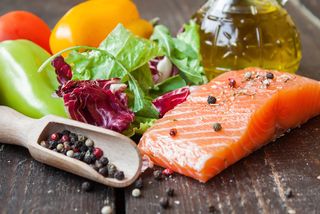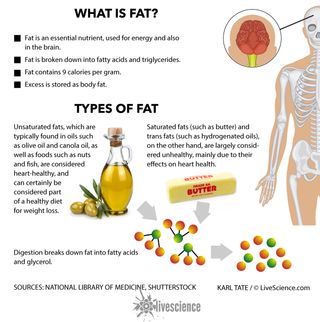What Are Triglycerides?

Triglycerides are a type of fat found in the blood. They are the most common type of fat in the body. Triglycerides are necessary for health but in excess amounts, they may be harmful and may increase the risk of heart disease. For this reason, scientists think that triglyceride levels may be an important measure of metabolic health.
"When you eat more calories than you need, the body stores those calories in the form of triglycerides, which can be used later by the body for energy," said Dr. Lauri Wright, a registered dietitian, member of the Academy of Nutrition and Dietetics, and an assistant professor of nutrition at the University of South Florida.
Most of the fats we eat, such as natural oils — both polyunsaturated and monounsaturated — animal fats and trans fats, are triglycerides. While both healthy and unhealthy fats contribute to triglyceride levels, trans fats like margarine and saturated fats like fatty red meats, poultry skin, lard and some full-fat dairy products can elevate triglyceride levels more than leaner cuts of meat and unsaturated fats like olive oil, avocados, nuts and low-fat dairy products. Refined, simple carbohydrates and alcohol can also increase triglyceride levels, said Wright.
High triglyceride levels can also be a side effect of medications like beta blockers, birth control pills, steroids and diuretics, according to the Mayo Clinic.
Lipids
Triglycerides and cholesterol both belong to the "fat family" (also called lipids) but have different functions, said Wright. "Cholesterol is a fat-like substance that is used by the body to make hormones, vitamin D and is part of the membrane surrounding the cells," she added. Cholesterol is waxy and odorless. The liver produces it from animal foods.
According to the Cleveland Clinic, cholesterol and triglycerides in their pure forms cannot mix with blood. As a result, the liver sends them out with proteins in packages called lipoproteins. Lipoproteins move cholesterol and triglycerides throughout the bloodstream.
There are three types of lipoproteins, according to the University of Colorado Health Sciences Center. They are low density lipoproteins (LDL), very low density lipoproteins (VLDL), and high density lipoproteins (HDL). LDL, also called LDL cholesterol, is considered the "bad" kind of lipoprotein because it contributes to plaque buildup in the arteries. HDL cholesterol is considered good because it removes LDL from the arteries, according to the American Heart Association.
Dangers of high triglyceride levels
"If triglyceride levels are too high in the blood, they can cause plaque buildup in the arteries," explained Wright. Scientists are not sure how or why triglycerides cause plaque buildup, but they do know that people with high levels of triglycerides are more likely to have high LDL levels. When plaque builds up in the arteries, artery walls can harden or become thick, which is called atherosclerosis.
Atherosclerosis increases the risk of heart attack, stroke and heart disease. According to the National Institutes of Health (NIH), women are especially at risk of heart disease if they have high triglyceride levels. Scientists think that high triglyceride levels can also indicate other conditions that increase the risk of these diseases, such as obesity and metabolic syndrome.
Extremely high triglyceride levels can lead to acute pancreatitis, according to the Mayo Clinic. They may also be a sign of type 2 diabetes, hypothyroidism, kidney disease, and liver disease or rare genetic conditions that deal with metabolism.
The American Heart Association notes that more research is needed to be sure that high triglyceride levels are an independent risk for heart and other diseases. These diseases have other risk factors, such as high cholesterol, so the role of triglycerides is still being determined. Several case studies have shown that triglycerides could be an independent disease risk factor, however. Furthermore, a 2007 study published in Annals of Internal Medicine found that young men with the highest triglyceride levels had a four times greater risk of developing heart disease or having a stroke than similarly aged patients with the lowest triglyceride levels.
Normal triglyceride levels
You need some triglycerides to live healthily. Here are Wright's guidelines to triglyceride levels in the blood:
- Normal: Less than 150 milligrams per deciliter (mg/dL), or less than 1.7 millimoles per liter (mmol/L)
- Borderline high: 150 to 199 mg/dL (1.8 to 2.2 mmol/L)
- High: 200 to 499 mg/dL (2.3 to 5.6 mmol/L)
- Very high: 500 mg/dL or above (5.7 mmol/L or above)
Measuring triglyceride levels
It is easy to find out your triglyceride levels. Your doctor can determine them with a simple blood test. They are usually measured whenever your doctor conducts a blood test called a lipid profile, which measures your total cholesterol level, HDL level, LDL level, and triglyceride level. The American Heart Association recommends that everyone older than 20 have their lipid profile checked at least every 4 to 6 years. If your levels are elevated, you may need to be tested more often.
It is normal for triglyceride levels to be high after you eat. For this reason, doctors recommend waiting 12 hours after eating or drinking to have your triglyceride levels tested. Other factors that may affect triglyceride level test results include blood alcohol levels, menstrual cycle, recent exercise and the time of day, according to the Cleveland Clinic.

Lowering triglycerides
If you've had your triglycerides tested and are worried about high levels, you can take actions to lower them. Most actions involve improving your diet and exercise habits. Wright provided the following advice for lowering your triglyceride levels:
- Lose weight. If you're overweight, losing 5 to 10 pounds can help lower your triglycerides.
- Avoid sugary and refined foods. Simple carbohydrates, such as sugar, can increase triglycerides.
- Choose healthier fats. Trade saturated fat found in meats for healthier monounsaturated fat found in plants, such as olive, peanut and canola oils. Substitute fish high in omega-3 fatty acids, such as mackerel and salmon, for red meat.
- Limit how much alcohol you drink. Alcohol is high in calories and sugar and has been shown to raise triglyceride levels.
If making healthy lifestyle changes doesn't sufficiently lower your triglyceride levels, your doctor may prescribe medicines to take in conjunction with a good diet and exercise regime. The following medicines are often prescribed, according to the Mayo Clinic:
Niacin
Niacin is also known as vitamin B3 and nicotinic acid. It is a water-soluble vitamin important for a healthy body, and is normally acquired through foods like milk, eggs, rice, fish, lean meats and legumes, according to the NIH. For people with high triglyceride levels or high LDL cholesterol, a very high dose of niacin may be prescribed. It is important not to take prescription-strength niacin without a prescription because in large, unregulated doses it can be toxic. It can also interact with other medications to your detriment.
Niacin is usually only prescribed to people with triglyceride levels over 500 mg/dL (5.7 mmol/L). According to the Mayo Clinic, niacin can raise HDL (good) cholesterol levels by more than 30 percent. It has also been linked to slowing atherosclerosis, heart attack and stroke when paired with statins or colestipol (other cholesterol-lowering medications), according to the University of Maryland Medical Center.
Statins
Statins are well known for their cholesterol-lowering abilities. These drugs include atorvastatin (Lipitor) and simvastatin (Zocor). Statins interfere with the liver's production of LDL cholesterol and raise HDL cholesterol levels. They are typically prescribed for people with high LDL cholesterol levels or histories of clogged arteries or diabetes. While they are relatively safe for most people, muscle pain is a common side effect.
Omega-3 fatty acids
Found in fish oil, these healthy fatty acids are an important part of any good diet. In high doses, they can help lower triglyceride levels. Scientists theorize that omega-3 fatty acids' ability to lower inflammation could be related to its triglyceride-lowering capabilities, according to an article in Biochimica et Biophysica Acta. Because high doses of fish oil can add a great deal of calories, interfere with blood clotting and cause nausea and diarrhea, prescription-strength omega-3 fatty acid supplements are only given to people with triglyceride levels higher than500 mg/dL (5.7 mmol/L). Some names of prescription-strength fish oil are Epanova, Lovaza and Vascepa. Fish oil does not lower cholesterol.
Fibrates
These drugs are derivatives of fibric acid. They are typically prescribed to people with very high triglyceride levels — more than 500 mg/dL (5.7 mmol/L). They lower LDL cholesterol levels as well, though somewhat less successfully than they do triglycerides, according to the U.S. National Library of Medicine. They are usually taken in conjunction with statins when used primarily for lowering cholesterol levels. The mechanism by which fibrates lower triglyceride levels is unknown, though scientists hypothesize that it involves regulating the liver's release of triglycerides in lipoproteins.
Additional resources
Sign up for the Live Science daily newsletter now
Get the world’s most fascinating discoveries delivered straight to your inbox.
Jessie Szalay is a contributing writer to FSR Magazine. Prior to writing for Live Science, she was an editor at Living Social. She holds an MFA in nonfiction writing from George Mason University and a bachelor's degree in sociology from Kenyon College.
